
Gamification is one of those buzzwords that started gaining more and more popularity a few years ago. Lots of companies tried to implement some sort of gamification mechanic in their products, but very few did that right.
Why it’s important for us to understand what gamification is and how it works? Adding gaming elements to an experience can be a very powerful tool because the idea of play is in our DNA. Humans have played games since forever, as all mammals1 (and not just them) do. Even if we, sadly, stop playing or drastically reduce its amount, when we grow up, the idea of “game” is very familiar to us and can trigger powerful emotions and memories.
There is a lot of psychology in gamification, as you can imagine, but, to keep things simple, let’s keep the conversation on a very practical level, by analyzing which products are effectively using this strategy, what techniques we can apply and how, and, in general, what to do and what to avoid.
But what does “gamification” mean? I think the definition proposed by the Interaction Design Foundation is on point:
“Gamification is a technique where designers insert gameplay elements in non-gaming settings so as to enhance user engagement with a product or service. By weaving suitably fun features such as leaderboards and badges into an existing system, designers tap users’ intrinsic motivations so they enjoy using it.”
The first thing to notice is that you can’t use gamification in games, this is quite obvious. Gamification is bringing gaming mechanics to products that are not games, such as educational products, social media platforms, ratings and reviews platforms, fitness tracking apps, and so on. Too often though, gamification has been implemented as it was a magic potion to boost engagement and content virality. Don’t expect a badge system or a digital stickers album to make a boring product engaging and fun. Gamification can help users being more motivated in using the product, but it can’t be the only thing you rely on, a common mistake is to think of this technique as a way to make a product a success, but it’s not that easy: if a product is bad, gamification alone can’t save it.
Nonetheless, if done right, it can be a very successful way to make your product more enjoyable.
Motivation is one of the main reasons for implementing gamification into a product. Cognitive psychology defines two different kinds of motivation: intrinsic and extrinsic.
Intrinsic motivation has been studied in psychology since the early 1970s, and it occurs when the desire to do something is coming from you; there are no external factors influencing your eagerness to accomplish this thing. For example, you want to learn to play guitar because you want to learn a new skill and play some music.
Being extrinsically motivated, instead, means that the need to do something is influenced by external factors, like getting a reward or avoiding punishment, for example, slowing down while driving to avoid a ticket.
Even if being intrinsically motivated seems the most desirable of the situations, neither of these is actually better — they both work. A study found that praise can help to increase intrinsic motivation in children (and adults), if the positive feedback is sincere, promotes autonomy, and conveys realistic and attainable standards. But the same study points out how the effect of praise on motivation is a complex matter, influenced also by the age, gender, and culture of the recipient, and in some cases could even be detrimental.
Gamification comes into play (pun intended) when we talk about extrinsic motivation. It’s a tool to provide a sense of reward, being it the top spot on a leaderboard, unlocking new content or any other mechanic that we’ll discuss shortly.
In a way, it’s a trick to divert intrinsic motivation. A child might not be too intrinsically motivated in learning math, but they might be so in getting the top spot in their classroom’s leaderboard at a math game. So gamification, working as an extrinsic motivator, is mediating this intrinsic motivation from math to the game that, at the end of the day, is teaching math to the child.
Let’s take a look at some examples of good gamification in digital products.
Duolingo is an app to learn languages that heavily relies on gamification to motivate its users to make progress and keep on learning.
The app presents a series of achievements and related badges that users unlock by completing activities and by using the app every day to unlock streak badges.
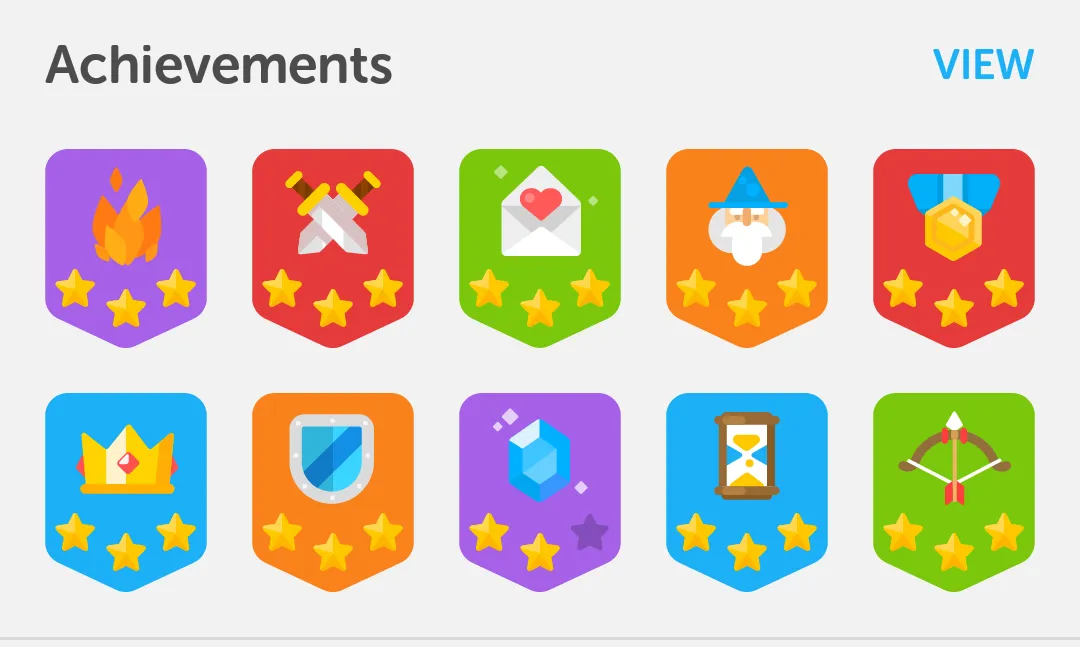
Gamification is so much embedded into Duolingo’s user experience that they even did a co-branding activation with Angry Birds, the super-popular arcade mobile game by Rovio, thanks also to the fact that they both have birds as mascots.
Mimo is an app to learn coding (Python, Java, React…) that utilizes a gamification mechanic that is very similar to Duolingo. Leaderboards, streaks, experience points, daily goals… I used it myself to learn some Python and I have to say it really worked for me. I can’t say I’m a Python dev now, but I learned the basics in a very enjoyable way.
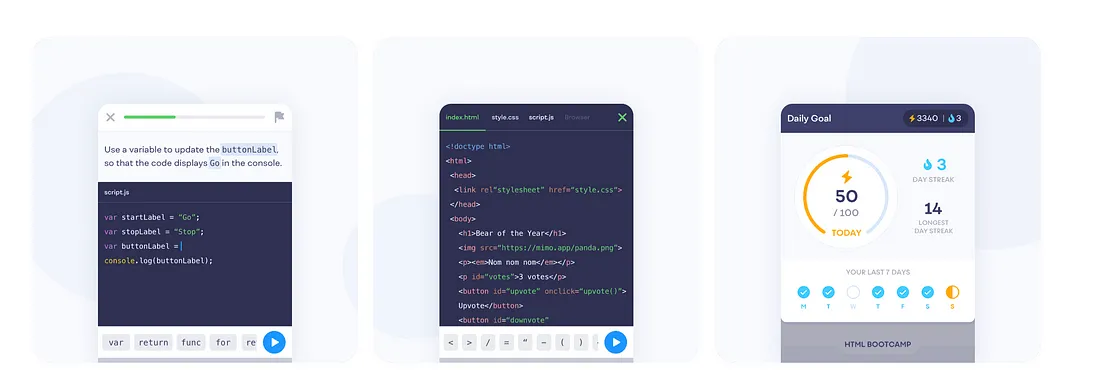
In the fitness world, many products use gamification techniques, because the idea of challenges, rewards, and goals perfectly fits sports activities. One of the first to do so has been Nike with its Nike+ platform (now called Nike Run Club). Users can see their results, unlock achievements, compare with and challenge friends, and so on. It’s a great tool to boost motivation and keep users engaged helping them developing a daily habit.

Still in the wellness realm is the example of the health rings in the Apple Watch. Apple Watch introduced to the mass public the idea of tracking your daily physical activity to be healthy. The app has three rings to measure how much you move, you exercise, and you stand during your day. By closing these rings, users get notifications and badges to keep them motivated, the more days in a row they close all the rings, the more prestigious badges they unlock. This mechanic is so powerful that some people took it as a way of life, arriving to close all rings in a streak years-long.
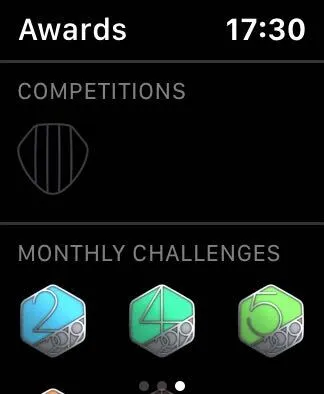
Swarm is the heir of Foursquare which has been maybe the first location-based social media. It introduced the idea of “check-in” as a way for users to communicate with their contacts what restaurant or shop or other business or place they are visiting in real-time. The more someone visits places, the more badges unlock; by visiting the same place regularly, a user can become the “mayor” of that place. Even though Foursquare is not as popular as it was when it launched, it’s still a good example of gamification applied to real-life events.
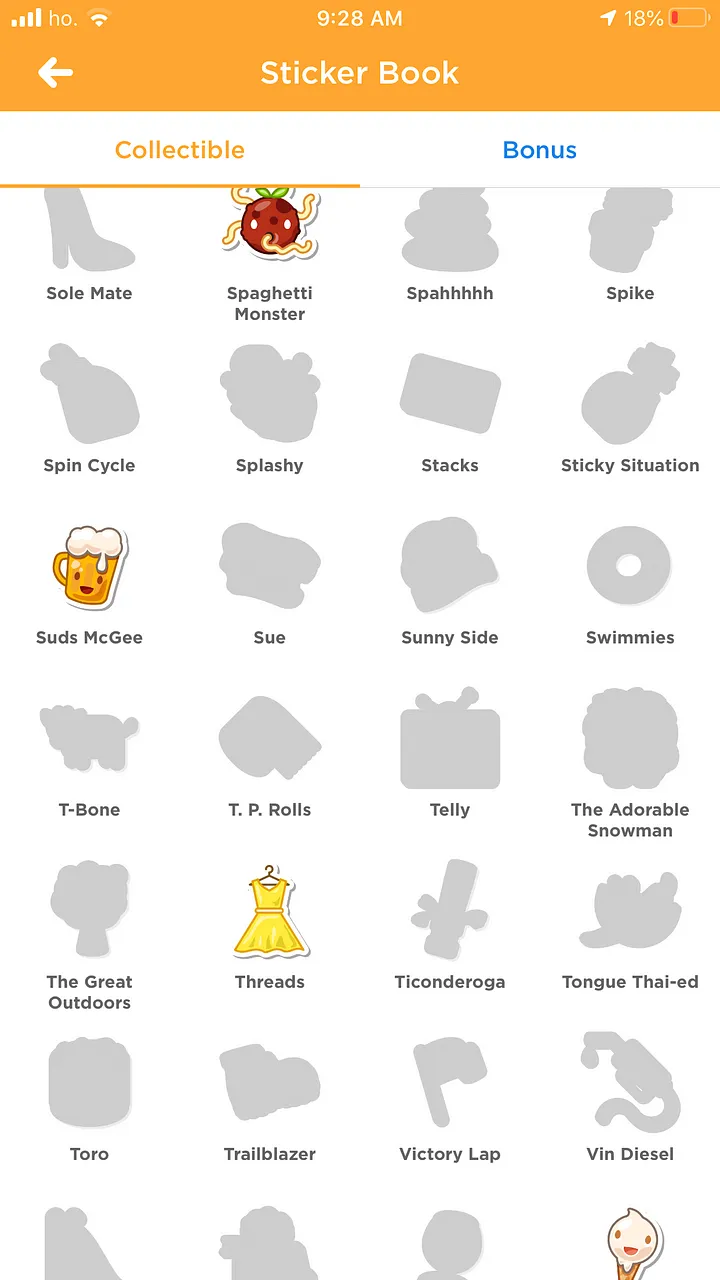
Although not as popular as the previous examples, Epic Win was, nonetheless, a very compelling case for gamification. Probably one of the most extreme attempts of implementing a gaming mechanic to a utility app, Epic Win is an RPG (role-playing game) version of a to-do list app. Doing your tasks and chores lets you earn experience points, unlock loot, upgrade your character, and more.
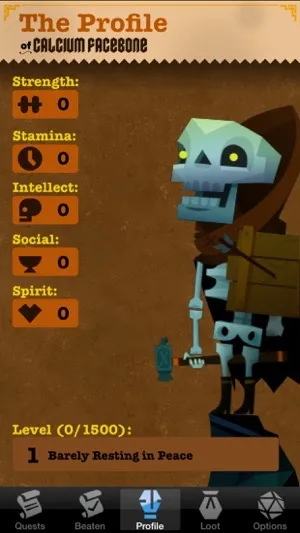
There are lots of examples in children’s products; here I selected a couple that are interesting because they don’t use gamification in the usual educational setting.
One is Brushing Hero, an app to engage kids into washing their teeth for the right amount of time. Using AR (augmented reality) and face recognition, the kids see themselves as knight fighting monsters. The more they brush, the more they hit the enemies and collect points to level up their character.
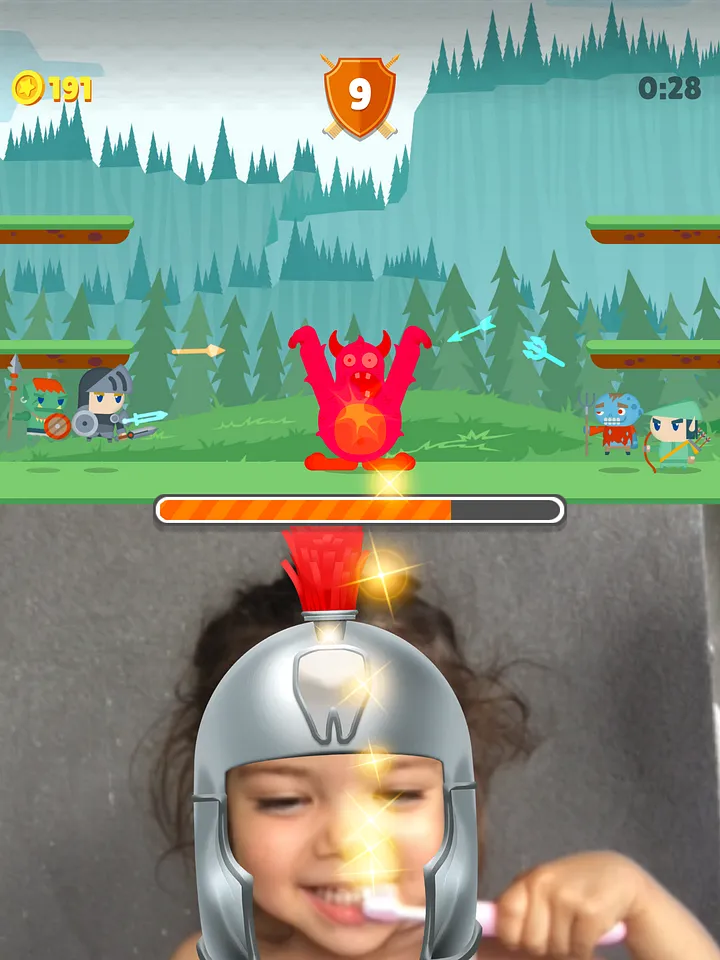
The second example is the mindfulness app Stop, Breathe & Think Kids. By completing meditation and mindfulness exercises, children can unlock digital goods. It’s a very simple mechanic, but it’s interesting seeing it applied to this kind of experience.
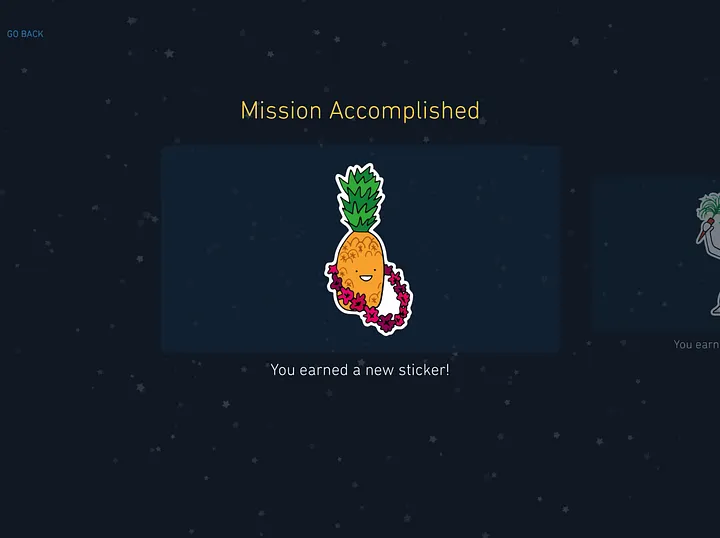
Now that we took a look at some famous applications of gamification, we can identify exactly which are the components and the tools at our disposal to apply them effectively to our product.
These components are what most video games have in common. As I said earlier in this chapter, you can’t apply gamification to a video game, simply because gamifying means bringing a non-game product closer to a game, and a video game is, of course, a game already. What you can do is learning from video games. Analyze what makes such products fun and engaging and try to distill those components and, then, experiment how to apply them to a non-game product.
Some examples of gamification components, which can be used alone or in combination, are as follows:
As you can see by reading these descriptions, many of these components are interconnected. Experience points can determine your level that unlocks upgrades to get achievements and unlock badges, and these can reward you with additional experience points and so on. Understanding these mechanics is important to design proper gamification. Having these ingredients randomly sprinkled on a digital product makes for a very poor (i.e., nonexistent) gamification strategy. It’s important, then, to have a good understanding of how you can put these pieces together and create a circular mechanic, like the simple one I described earlier, where the last link of the chain is connected to the first one in an endless loop.
Of course, not all products and their target users are the same. For this reason, it is important to understand your users, what moves them, what are their motivations, but also their skills, in order to develop effective gamification. The level of complexity you want to achieve depends on this; for example, you don’t want to create a complex RPG mechanic, with experience points, levels, power-ups, and in-app currency, for an app aimed to toddlers. In that case, a series of digital collectibles to unlock might be enough. But this probably would not mean too much for older kids, 10 or 12 years old, to whom digital stickers might not be engaging enough. Probably they would be more motivated and entertained by a more complex challenge, with a leaderboard to compare their results with friends and avatars to customize.
Another important thing to understand is that you can’t take a finished product and add a layer of gamification over it at the end of the design process. Defining and implementing the gamification strategy is an integral part of the user experience design concept since the very beginning. It’s not a module to plug in and out, it’s deeply nested into the experience at its very core. When it’s just added afterward, you can tell and it’s usually very bad gamification.
Here are some good principles to keep in mind when you design your gamification.
Gamification is not easy to implement. It’s, first of all, a matter of balance between the fun gaming elements and the real purpose of the product. It shouldn’t be so overwhelming to transform the nature of your product from its original scope to a full-fledged video game, so balance is very important when designing your gamification strategy. If your app wants to be primarily educational, be sure that’s the focus of the experience and the gaming component is the sugar to make swallowing the pill easier.
Badges, Points, and Leaderboard (BPL). That’s the most basic (and abused) of the gamification mechanics. It’s flexible enough to adapt to a wide array of products, it’s true, but you don’t want your product to be just another iteration of an old concept, right? Try to go beyond known patterns and already seen experiences.
Gamification strategies are not a mix-and-match thing. Each product and its audience requires custom-made gamification that can’t be copied and pasted over to another product. Especially in digital products for children, where a 2-year gap is very significant, as we have seen in the previous chapters, you have to be aware of who are your users, what interests them, what engages them, and plan accordingly. The ingredients might be the same, or very similar, but the way you cook them can be very different when designing for preschoolers or for 5th graders.
Yes, we use gamification in order to engage and motivate users, but we don’t want them to become addicted to our product. The line between motivation and obsession can be very thin at times, considering the age of our little users we have to be mindful of the time they spend on the device (yes, screen time once again). If we were just looking at raw numbers, addiction would be a sign of perfect gamification, we maximized the engagement to the point where users find it very hard to stop using the product. Sounds great, right? Well, no. Promoting a conscious and healthy use of our digital product is part of its UX.
Aza Raskin (son of Jef Raskin, the initiator of the Macintosh project at Apple) is largely credited as the inventor of the “endless scrolling” pattern, we are used to experience in Facebook, Twitter, Instagram, and other products. After a few years this pattern became ubiquitous, he expressed his apologies4 for creating such addictive interaction, the consequences of which he could not foresee.
As designers, we can’t consider engagement a success per se; we need to consider it in a larger context where the user’s well-being is our primary interest.